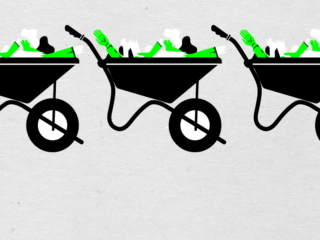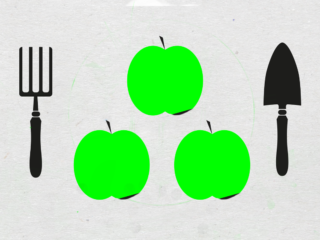
It’s a rare garden programme, article or podcast that doesn’t end with a ”Now is the perfect time to…” slot, telling you what jobs you should be prioritising this week or month. You might think the torrents of advice would slow down in winter, when the main growing season is over. Not so much. Even in the shortest, darkest days of the year, gardeners are burdened with lots of well-meant suggestions about what they should be putting at the top of their to-do list, and never mind the howling wind and lashing rain.
Thinky, indoorsy jobs involving planning are definitely worth doing now – things like working out what you are going to grow next year and where you’re going to grow it, ordering any seed you need before the mail-order suppliers run out, or creating a sowing, planting and harvesting calendar (the one in our book is a good starting point). But a lot of other so-called winter jobs can either wait, or don’t really need doing at all. So, in the interests of maximising time in front of the telly wearing slipper-socks and eating Cadbury’s Heroes, here’s five garden chores we think you actively shouldn’t tackle this winter.
DON’T sterilise
Once upon a time, gardeners would be told to carefully wash and sterilise all their pots and seed trays at the end of every year, to kill off any overwintering bacteria or fungi. These days, sterilising all your growing equipment probably is worth doing if you’re running a commercial plant nursery and don’t want to risk losing any of next year’s seedlings. But for most of us amateur veg-growers, losing the odd seedling is not worth worrying about. In our early zombie-gardening years we dutifully went through the whole washing, sterilising, brushing out and drying routine. After we got fed up swilling around buckets of smelly, environmentally dubious chemicals, we moved on to just dunking pots and module trays in a bucket of cold water. These days, we don’t even do that, just tapping out the worst of any leftover growing media before stacking our pots on the potting shed shelves. Call us Mr and Mrs Slobby, but guess what? Our seedlings haven’t suffered at all.
DON’T dig
Back in the day, gardeners with heavier or clay soils were told to dig over all their veg beds in early winter, to get rid of weeds and allow frost to break up the clods and leave a nice crumbly tilth ready to sow into in the spring. But – thank you, climate change – UK winters are generally much rainier and milder than they used to be. There’s often not much to frost to be had and, worse, digging heavy soil when it’s really wet wrecks it, destroying something called its “structure”: vital little pockets of air that separate the mineral particles, and allow roots to grow, exchange gases and absorb nutrients. So if you’ve got an empty, weedy bed that isn’t hosting any overwintering crops or green manure, don’t dig it. Instead, cover it with something reasonably heavy, like tarpaulin or a layer of weighted-down cardboard. And… just leave it. In spring, once the soil begins to warm and dry out, take the covers/cardboard off. You should find the bed clean and clear of everything except the toughest perennial weeds, and all you’ll need to do before sowing is either add a layer of well-rotted compost, or give the soil a quick fork-and-rake.
DON’T plant
You’ll have heard the advice that pot-grown fruit bushes and trees can be planted “at any time of year”? And that if they’re bare-rooted (sold pot-less, with their roots wrapped in a bag) they can be planted “any time from November to March”? Hmm. First, there’s what we said about digging heavy soil when it’s wet. But even if you’re gardening on lighter, sandy soils, if you put large plants in the ground early in the winter, they’re going to get knocked about by wind, and possibly frost heave, before their roots have had time to establish really good contact with the soil. Yes you might have taken care to stake them, but there’s still a chance roots will rock out of position, meaning some will dry out in the spring and reduce the young plant’s ability to establish itself – in some cases, it might even die. This is why we tend to plant pot-grown plants in September or early October, when the soil is still warm from summer and the roots can romp away right up until the first frosts. And also why we try to leave planting bare-rooted fruit trees and bushes until almost the end of February, just before they break out of dormancy. By then, the most-mean-spirited of the winter weather should be over.
DON’T hedge
The usual advice for anyone interested in protecting the environment is to only cut hedges in winter, when birds won’t be nesting in them. If you’re lucky enough to have hedges in or around your zombie garden, we’d go further: only cut them right at the end of winter, and then only once every two to three years. That’s because taller, fuller hedges are better at filtering out the strong winds that otherwise can knock flat tall winter crops such as Brussels sprouts or kale, and the stiller air between them creates a kinder microclimate for early spring growth. If you’re worried about an uncut hedge shading out your growing area, divide it into three sections and only cut back one section each year. That way you’ll create a hedge with different heights along its length, which has the added bonus of attracting a wider variety of bird and insect species. Building better biodiversity, with a range of predators and food sources, means less chance of one particular pest predominating and ripping through your veg patch.
DON’T prune
For apple or pear trees, winter is absolutely the right time to prune. It’s just that full-grown apples and pears don’t really need pruning. Or at least not every year. If you nip a third off the end of all of this season’s growth you will, yes, mildly encourage the growth of new fruiting spurs. But unless you’re an actual fruit farmer, you’re not going to notice much difference from one year to the next: things like the weather, pests and soil fertility will have a much bigger effect on the size of your crop. So if you’ve planted a baby apple or pear, prune it every winter for the first four or five years to help it grow in an open, easy-to-harvest-from shape. After that, as long as your trees are healthy, you can mostly ignore them – and get back to that box of Heroes instead.
FRUITING SPURS Not to be confused with the north London football team, “spurs“ are short, stubby growths studded along the branches of apple and pear trees, and are where the tree’s blossom and fruit form. They are both productive and useful – which is why they shouldn’t be confused with the north London football team.










